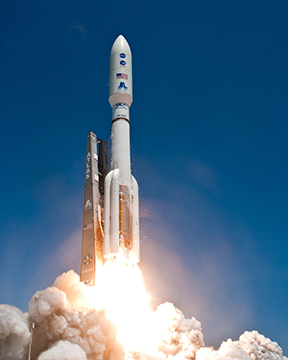 While families across the United States are celebrating the Fourth of July, NASA will be playing its own version of catch in the cosmic backyard, and an Aggie is playing a critical role in the mission.
While families across the United States are celebrating the Fourth of July, NASA will be playing its own version of catch in the cosmic backyard, and an Aggie is playing a critical role in the mission.
If all goes as planned, NASA’s Juno spacecraft, which is about the size of a basketball court and launched almost five years ago on August 5, 2011, will complete its Jupiter orbital insertion maneuver at about 10:30 p.m. CST on Monday, locking Juno into orbit around the solar system’s largest planet.
Sammy Kayali, Texas A&M class of ’87 in electrical engineering and a mission assurance manager for Juno at the NASA Jet Propulsion Lab (JPL), said this is an exciting week after almost a decade of preparation.
 “Most of us here have been working on this for quite a while,” he said. “We launched it in 2011 (pictured right), and it’s taken five years to get there. We worked on it for five years before that, so it’s been 10 years since we really got started on this mission. We’re really excited.”
“Most of us here have been working on this for quite a while,” he said. “We launched it in 2011 (pictured right), and it’s taken five years to get there. We worked on it for five years before that, so it’s been 10 years since we really got started on this mission. We’re really excited.”
Kayali’s role as a mission assurance manager is to ensure all of the different parts of the spacecraft pass the requirements of the mission and don’t introduce any additional risk. He and his colleagues review and test the designs to make sure mission objective and science goals are met.
It’s an important role on any mission, but particularly this one because of some of the challenges that Jupiter poses to incoming spacecraft. Most obviously, Jupiter is a long way from Earth. So far, that Juno’s radio signal takes 48 minutes to arrive on Earth. If anything in the system goes wrong, there will be nothing anyone on the ground can do about it.
“The biggest challenge to this mission is the radiation environment at Jupiter,” he said. “It’s a massive planet with a very prominent magnetic field. The radiation environment is orders of magnitude higher than we’ve seen on any mission in the past. It’s like having to survive through a nuclear blast.”
On the surface, getting into orbit around a planet that has 67 moons might not seem that difficult, but it isn’t quite as simple as just getting close.
“The spacecraft has to do a lot of things in preparation of the Jupiter orbit insertion maneuver,” Kayali said. “It has to slow down to a speed that allows it to be captured by Jupiter’s gravity field. From there it will orbit Jupiter for a little over a year and collect a lot of meaningful science that will help us understand the origin of the planet and the solar system. The weather patterns on Jupiter have a lot in common with the weather patterns on Earth, so there’s a lot of exciting science to understand and benefit from in the future.”
The mission aims to answer a number of questions about the massive planet, including what exactly is hiding beneath its swirling clouds. That question is actually how the mission got its name. According to Roman mythology, Jupiter used clouds in order to hide when he was causing trouble, but his wife Juno was able to see through them.
As a NASA mission, Juno is an American spacecraft, and Kayali said that having such a critical part of the mission come on the Fourth of July is special, but also emphasized the international cooperation that it takes for such a mission.
“There are contributions from all over the world,” he said. “We have scientists involved from England, Italy, France, Germany, Switzerland and all over the world, essentially. A number of contributions came from foreign countries, so this is really an international mission that shows you how scientists can work together regardless of nationalities and borders.”
Before attending Texas A&M, Kayali grew up in Houston, and also holds a degree from Sam Houston State University. He said he’s far from the only person from the Lone Star State working at the NASA Jet Propulsion Lab in Pasadena, California.
“I certainly enjoyed my time at A&M. I had an excellent education and I’m very proud to be an Aggie. There are a few Texas Aggies here, and there are also a few UT graduates and some other alumni of Texas schools. At the JPL they recognize the education system in Texas is very good. It’s a place we continue to recruit from and get great candidates. It’s always good to have people who know what the history is all about in Aggieland.”
For more information on Juno, check out the mission website: https://www.missionjuno.swri.edu/